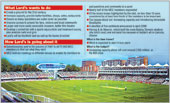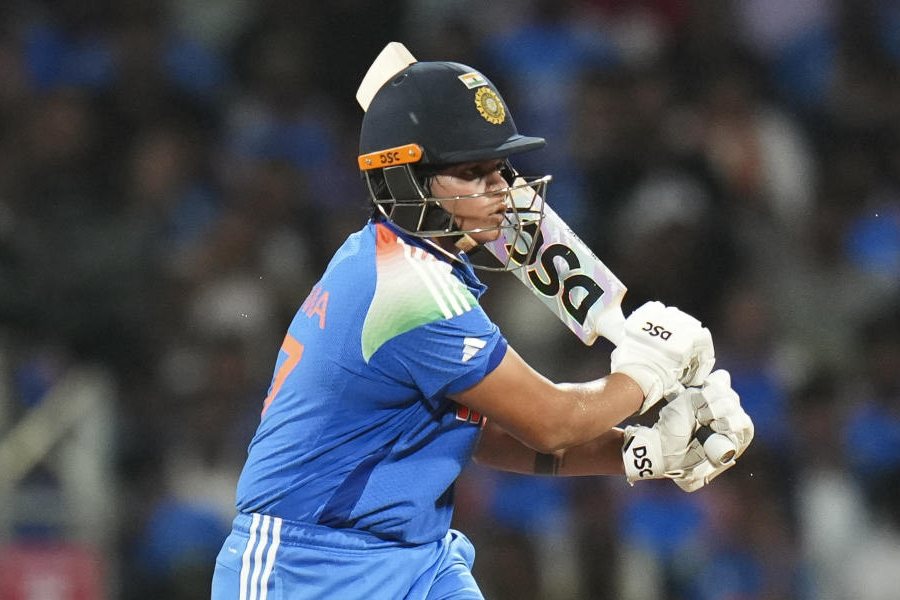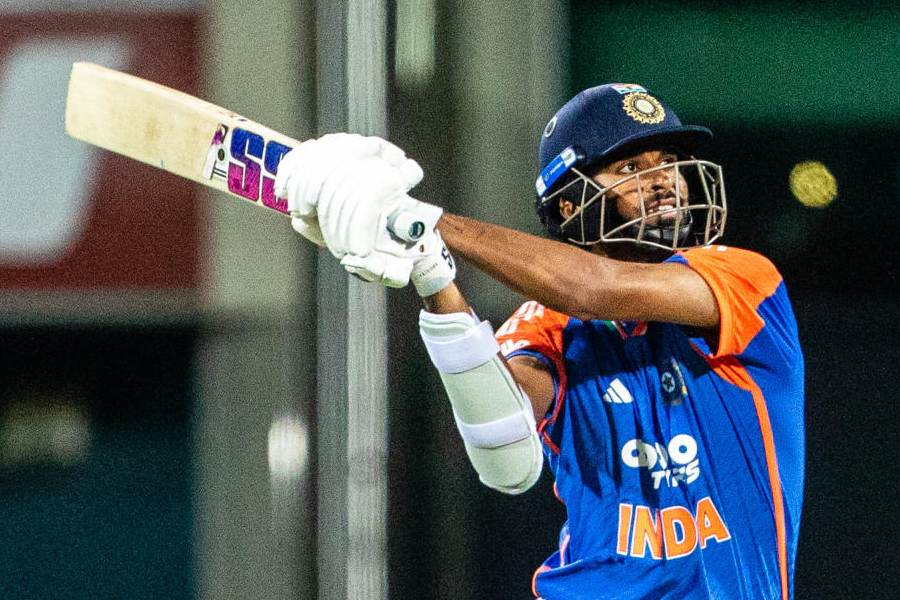 |
| The Lord’s cricket ground |
India’s largest cricket stadium is readying for a nip-and-tuck before the 2011 World Cup. But will it be any better?
Eden Gardens is heading into a facelift to doll up for World Cup 2011 with little sign that it will be any different from the piling of concrete upon ugly concrete it’s been a victim of for the past several decades.
The tournament is two-and-a-half-years away but the Cricket Association of Bengal (CAB) that reigns, with the army’s boots on the throne, over Calcutta’s most famous patch of green has only a foggy idea of which apple to pluck for the Eden or which snake to let loose.
Architects have not been spoken to, a budget is not in place.
Prasun Mukherjee, the CAB president who took charge in a blaze of publicity around this time last year, said: “The land belongs to them (the army). We cannot start construction unless the lease is renewed.”
While that is true — the application for renewal has been lying with the defence ministry for over a year — Eden Gardens has already fallen behind the Wankhede stadium in the nip-and-tuck run. Wankhede has already submitted its plan to the Board of Control for Cricket in India, hired an architect and set its budget at Rs 100 crore.
Wankhede will renovate the north and south stands, put bucket seats to replace the concrete slabs and add toilets and food kiosks.
Along with the application for lease renewal, the CAB has presented the lofty vision of blessing the stadium with a “uniform look”. It admits that “different stands and galleries have been constructed at different times without a common theme”.
The proposals include a bottom-warming promise to “renovate all the galleries to provide for bucket seats with comfortable leg space”. Estimates suggest the cost could be between Rs 100 and 200 crore.
The gods of Eden so far haven’t lost sleep over comforts for their subjects, though the nazrana for a dekko of the demigods that grace its greens has reached heavenly heights. The lowest season ticket for the England Test in 1993 cost Rs 40; a dozen years later for the Pakistan match it had swelled nearly four times to Rs 150. At the higher end, the trajectory is even more spectacular — from Rs 200 to Rs 1,200 over the same period. But all the real estate the seat of your pants gets for that money remains at 14 inches of harsh concrete.
 |
| Eden Gardens lit up for an ODI. A Telegraph picture |
That Eden Gardens, where cricket was first played on February 23, 1792, is not fit for the thump and fling of T20 became evident in the opening IPL season when the lack of a giant screen discouraged Team SRK from staging its big bump-and-grind show. There was also the small matter of the floodlights going on the blink and a game being washed off by rain.
“While the drainage has got to improve, there ought to be a motorised system for covering the ground,” said a senior official of Shah Rukh’s Red Chillies Entertainment.
The last time drainage was re-laid at the Eden is as much a sepia-tinted memory as pictures of Kapil Dev holding aloft the Prudential Cup. It was the same year, 1983, after the world cup victory and before the Malcolm Marshall mauling.
Pabitra De Sarkar, who was an executive engineer with the public works department (PWD) that oversaw the laying, said: “The (perforated on the upper side) pipes were laid radially from the area around the pitch and drained the water into the circular drain on the periphery of the playing area.” He agreed that the drainage was unlikely to have the longevity of the memory of the 1983 win.
 |
Mukherjee, who later this month heads into possibly another bruising election battle against the redoubtable Jagmohan Dalmiya, associated with the Eden for three decades, vowed to pitch for the best technology as “such infrastructure overhauls do not happen every day”. “We will most probably go for the technology they use in golf courses.”
Manmohan Singh, the CEO of the Royal Calcutta Golf Club, explained: “We have drainage at three different depths for the greens, bunkers and fairways. There are layers of stone chips and sand above the pipes. Experts check the permeability of the soil to see if water can flow vertically into the perforation in the pipes.”
The gruesome concrete galleries that have galled spectators over the years are of even older vintage, built 29 years ago. Subsequent additions have followed the same 14-inch size-zero model. “The first time I went to the concrete stands, I was sure it was a space marked out for kids,” said Subhadip Sen.
In 1979, before Asif Iqbal’s Pakistan toured India, the PWD was asked to replace the wooden galleries with concrete. “We had exactly 114 days to complete all the galleries except Block D, which was already concrete,” said Sarkar. The seats were made of pre-cast concrete. “It was too late when we realised the leg space was too cramped.”
Few will dispute that. Many more may be getting the feeling that the CAB could find itself cramped for time 30 years on since work can’t start before next year, and rubbing their knees in anticipation of the soreness to come for years after that.
Did the CAB leave applying for renewal until too late — a month to the lease expiry? Mukherjee replied: “It’s no use asking hypothetical questions.”
Foes they may be on the poll pitch, but on this Dalmiya’s views aren’t any different from Mukherjee’s. “How can it? The lease is yet to be renewed,” he said when asked if work could have been started.
Arun Lakhanpal, the chief designer and associate in Arun Loomba & Associates, the architects who handled India’s best stadium Mohali, said: “If Eden Gardens has to go for such a grand makeover, construction should have started by now. It will take a minimum of two years.”
Lakhanpal added that when his firm designed the stadium, its owners, the Punjab Cricket Association, showed some pictures of grounds, including the Eden — and that was all the idea it received. The architects took none of these models.
There’s little reason to believe that unlike the PCA its Bengal counterpart will be brimming with design concepts. And even less reason to suspect that it will hunt out the best in the business and hand the work over, like Lord’s has done.
The architects Herzog & de Meuron, who designed the main Beijing Olympic stadium with the bird’s nest shape, have been picked for the Lord’s job after a painstaking, yearlong process.
Mukherjee or Dalmiya, or whoever the next CAB president is, will not have the time — and there is nothing to suggest in the association’s history that it is even capable of thinking on a scale that Lord’s has — to attempt anything like this.
Along with the Howrah bridge and Victoria Memorial, Eden Gardens forms the landmark triumvirate Calcutta is known by. Unlike the other two, it’s not a pretty sight with its monstrous concrete shape heaving upwards, though when the lights are on and the hum of half a lakh and more fills the air, the giant comes alive in an awesome sight.
Talking of lights, it was clear during the IPL season that the current cluster of four, installed in 1993 when the Eden became the first cricket ground in India to be lit up, might have already had their day under the moon. It’s outdated and wasteful. In modern lighting arrangements, the arm of the towers hang right over the ground so that the centre is lit up brightly while the immediate surroundings of the stadium are dark.
One doesn’t know if the CAB is aware that Lord’s is even thinking of installing retractable floodlights in deference to the sentiments of the local populace who may not want their neighbourhood to be watched over by titanic towers. It could cost anywhere between £1 and 5 million.
A British newspaper wrote: “…a brisk southern hemisphere breeze is blowing through Lord’s in the guise of the newly appointed MCC secretary and chief executive Keith Bradshaw, an Australian brimming with energy, ideas, but above all a huge respect for what is in his hands.”
Eden Gardens and the city of Calcutta, to which it was gifted by the Eden sisters, ought to command the same respect. In another 10 years, Eden will complete 100 years of the first first-class match played there. Some might say that is a bigger occasion, coming around once in a century, than the World Cup, held every four years, to unveil a new Eden.
The time before 2011 might be enough to instal bucket seats but not for getting international architects to create an arena, not a stadium, fit for the eyes of gods. Maybe, Eden needs an Australian CEO.
Mr Mukherjee/Mr Dalmiya will be seeing visions of Greg Chappell.
India’s top 3
Mohali: Excellent facilities for players and spectators. Good wicket too.
Bangalore: Professionally managed, easy access for spectators.
Brabourne: Great atmosphere, again easy access for spectators.
World’s top 3
Lord’s: An experience which lasts; museum, gift shop — it has everything on and off the field.
Newlands (Cape Town): One of the most scenic, has great facilities.
Adelaide: It’s a ground you want to visit again and again. Excellent facilities, lovely setting.










